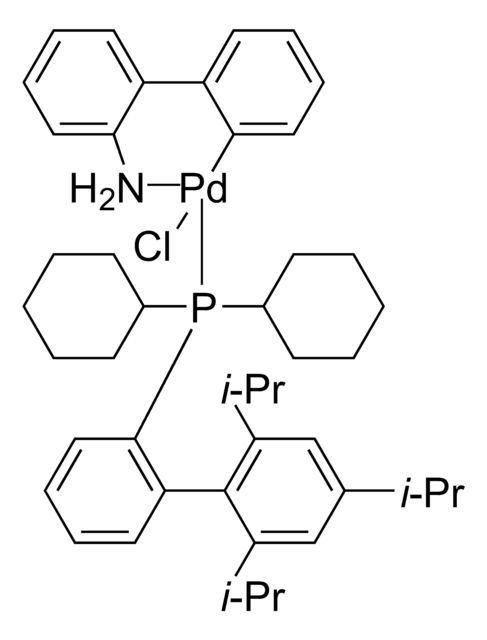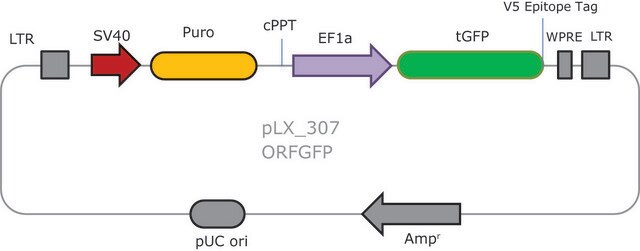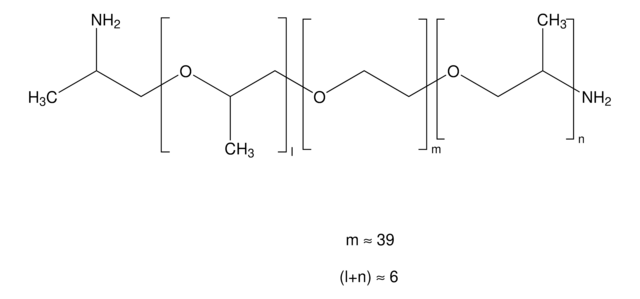17-10229
LentiBrite Histone H2B-GFP Lentiviral Biosensor
Sinonimo/i:
Histone H2B, Histone H2B GFP Biosensor
Autenticatiper visualizzare i prezzi riservati alla tua organizzazione & contrattuali
About This Item
Codice UNSPSC:
12352207
eCl@ss:
34360190
NACRES:
NA.32
Prodotti consigliati
Descrizione generale
Biosensors can be used to detect the presence/absence of a particular protein as well as the subcellular location of that protein within the live state of a cell. Fluorescent tags are often desired as a means to visualize the protein of interest within a cell by either fluorescent microscopy or time-lapse video capture. Visualizing live cells without disruption allows researchers to observe cellular conditions in real time.
Lentiviral vector systems are a popular research tool used to introduce gene products into cells. Lentiviral transfection has advantages over non-viral methods such as chemical-based transfection including higher-efficiency transfection of dividing and non-dividing cells, long-term stable expression of the transgene, and low immunogenicity.
EMD Millipore is introducing LentiBrite Lentiviral Biosensors, a new suite of pre-packaged lentiviral particles encoding important and foundational proteins of autophagy, apoptosis, and cell structure for visualization under different cell/disease states in live cell and in vitro analysis.
EMD Millipore’s LentiBrite Histone H2B-GFP lentiviral particles provide bright fluorescence and precise localization to enable live cell analysis of chromosomal dynamics in difficult-to-transfect cell types.
Lentiviral vector systems are a popular research tool used to introduce gene products into cells. Lentiviral transfection has advantages over non-viral methods such as chemical-based transfection including higher-efficiency transfection of dividing and non-dividing cells, long-term stable expression of the transgene, and low immunogenicity.
EMD Millipore is introducing LentiBrite Lentiviral Biosensors, a new suite of pre-packaged lentiviral particles encoding important and foundational proteins of autophagy, apoptosis, and cell structure for visualization under different cell/disease states in live cell and in vitro analysis.
- Pre-packaged, fluorescently-tagged with GFP & RFP
- Higher efficiency transfection as compared to traditional chemical-based and other non-viral-based transfection methods
- Ability to transfect dividing, non-dividing, and difficult-to-transfect cell types, such as primary cells or stem cells
- Non-disruptive towards cellular function
EMD Millipore’s LentiBrite Histone H2B-GFP lentiviral particles provide bright fluorescence and precise localization to enable live cell analysis of chromosomal dynamics in difficult-to-transfect cell types.
Chromatin, the higher order structure of DNA and nucleosomes, constitutes the majority of the nucleus of the eukaryotic cell. Changes in chromatin structure are the essence of many essential nuclear processes, including transcription, mitosis, meiosis, and apoptosis. The nucleosome comprises an octomer of four core histone proteins (H2A, H2B, H3 and H4). Genetic fusions between histone H2B and fluorescent proteins have been widely used in live cells to visualize the dynamics of chromosomal architecture during various processes. In addition to its utility for studying normal mitosis, histone H2B-GFP has been utilized to define mechanisms for asymmetric inheritance of oncogenic double minute chromosomes. Monitoring histone H2B-GFP also permits continuous analysis of chromosomal degradation during apoptosis. Use of histone H2B-GFP has recently been extended to live animals and high-throughput siRNA screens.
EMD Millipore’s LentiBrite Histone H2B-GFP lentiviral particles provide bright fluorescence and precise localization to enable live cell analysis of chromosomal dynamics in difficult-to-transfect cell types.
EMD Millipore’s LentiBrite Histone H2B-GFP lentiviral particles provide bright fluorescence and precise localization to enable live cell analysis of chromosomal dynamics in difficult-to-transfect cell types.
Applicazioni
Fluorescence microscopy imaging:
(See Figure 1 in datasheet)
HeLa cells were plated in a chamber slide and transduced with lentiviral particles at an MOI of 20 for 24 hours. After media replacement and 48 hours further incubation, cells were fixed with formaldehyde and mounted. Images were obtained by oil immersion wide-field fluorescence microscopy. The histone H2B-GFP appears solely associated with mitotic chromosomes.
Additional cell types and Hard-to-transfect cell types:
(See Figure 2 in datasheet)
U2OS cells transduced at an MOI of 20. The top cell displays telophase chromosomes, and the bottom cell contains anaphase chromosomes. HT1080 were transduced at an MOI of 40 for 24 hours. The two nuclei are in interphase. Primary cell types Human mesenchymal stem cells (HuMSC) were plated in chamber slides and transduced with lentiviral particles at an MOI of 40 for 24 hours. The three nuclei are in interphase.
Difficult-to-transfect cell types at various mitosis stages:
(See Figure 3 in datasheet)
Primary cell types HUVEC were plated in chamber slides and transduced with lentiviral particles at an MOI of 20 for 24 hours. The images show cells in various stages of mitosis.
For optimal fluorescent visualization, it is recommended to analyze the target expression level within 24-48 hrs after transfection/infection for optimal live cell analysis, as fluorescent intensity may dim over time, especially in difficult-to-transfect cell lines. Infected cells may be frozen down after successful transfection/infection and thawed in culture to retain positive fluorescent expression beyond 24-48 hrs. Length and intensity of fluorescent expression varies between cell lines. Higher MOIs may be required for difficult-to-transfect cell lines.
(See Figure 1 in datasheet)
HeLa cells were plated in a chamber slide and transduced with lentiviral particles at an MOI of 20 for 24 hours. After media replacement and 48 hours further incubation, cells were fixed with formaldehyde and mounted. Images were obtained by oil immersion wide-field fluorescence microscopy. The histone H2B-GFP appears solely associated with mitotic chromosomes.
Additional cell types and Hard-to-transfect cell types:
(See Figure 2 in datasheet)
U2OS cells transduced at an MOI of 20. The top cell displays telophase chromosomes, and the bottom cell contains anaphase chromosomes. HT1080 were transduced at an MOI of 40 for 24 hours. The two nuclei are in interphase. Primary cell types Human mesenchymal stem cells (HuMSC) were plated in chamber slides and transduced with lentiviral particles at an MOI of 40 for 24 hours. The three nuclei are in interphase.
Difficult-to-transfect cell types at various mitosis stages:
(See Figure 3 in datasheet)
Primary cell types HUVEC were plated in chamber slides and transduced with lentiviral particles at an MOI of 20 for 24 hours. The images show cells in various stages of mitosis.
For optimal fluorescent visualization, it is recommended to analyze the target expression level within 24-48 hrs after transfection/infection for optimal live cell analysis, as fluorescent intensity may dim over time, especially in difficult-to-transfect cell lines. Infected cells may be frozen down after successful transfection/infection and thawed in culture to retain positive fluorescent expression beyond 24-48 hrs. Length and intensity of fluorescent expression varies between cell lines. Higher MOIs may be required for difficult-to-transfect cell lines.
Research Category
Apoptosis & Cancer
Epigenetics & Nuclear Function
Apoptosis & Cancer
Epigenetics & Nuclear Function
Research Sub Category
Apoptosis - Additional
Cell Cycle, DNA Replication & Repair
Apoptosis - Additional
Cell Cycle, DNA Replication & Repair
Componenti
Histone H2B-TagGFP2 Lentivirus:
One vial containing 25 µL of lentiviral particles at a minimum of 3 x 10E8 infectious units (IFU) per mL.
For lot-specific titer information, please see lot specific “Viral Titer” in the product specifications of the datasheet.
Promoter
EF-1 (Elongation Factor-1)
Multiplicty of Infection (MOI)
MOI = Ratio of # of infectious lentiviral particles (IFU) to # of cells being infected.
Typical MOI values for high transduction efficiency and signal intensity are in the range of 20-40. For this target, some cell types may require lower MOIs (e.g., HT-1080, HeLa, human mesenchymal stem cells (HuMSC)), while others may require higher MOIs (e.g., human umbilical vein endothelial cells (HUVEC), U2OS).
NOTE: MOI should be titrated and optimized by the end user for each cell type and lentiviral target to achieve desired transduction efficiency and signal intensity.
One vial containing 25 µL of lentiviral particles at a minimum of 3 x 10E8 infectious units (IFU) per mL.
For lot-specific titer information, please see lot specific “Viral Titer” in the product specifications of the datasheet.
Promoter
EF-1 (Elongation Factor-1)
Multiplicty of Infection (MOI)
MOI = Ratio of # of infectious lentiviral particles (IFU) to # of cells being infected.
Typical MOI values for high transduction efficiency and signal intensity are in the range of 20-40. For this target, some cell types may require lower MOIs (e.g., HT-1080, HeLa, human mesenchymal stem cells (HuMSC)), while others may require higher MOIs (e.g., human umbilical vein endothelial cells (HUVEC), U2OS).
NOTE: MOI should be titrated and optimized by the end user for each cell type and lentiviral target to achieve desired transduction efficiency and signal intensity.
Qualità
Evaluated by transduction of HT-1080 cells and fluorescent imaging performed for assessment of target localization and transduction efficiency.
Stato fisico
PEG precipitation
Stoccaggio e stabilità
Storage and Handling
Lentivirus is stable for at least 4 months from date of receipt when stored at -80°C. After first thaw, place immediately on ice and freeze in working aliquots at -80°C. Frozen aliquots may be stored for at least 2 months. Further freeze/thaws may result in decreased virus titer and transduction efficiency.
IMPORTANT SAFETY NOTE
Replication-defective lentiviral vectors, such as the 3rd Generation vector provided in this product, are not known to cause any diseases in humans or animals. However, lentiviruses can integrate into the host cell genome and thus pose some risk of insertional mutagenesis. Material is a Risk Group 2 and should be handled under BSL2 controls. A detailed discussion of biosafety of lentiviral vectors is provided in Pauwels, K. et al. (2009). State-of-the-art lentiviral vectors for research use: Risk assessment and biosafety recommendations. Curr. Gene Ther. 9: 459-474.
Lentivirus is stable for at least 4 months from date of receipt when stored at -80°C. After first thaw, place immediately on ice and freeze in working aliquots at -80°C. Frozen aliquots may be stored for at least 2 months. Further freeze/thaws may result in decreased virus titer and transduction efficiency.
IMPORTANT SAFETY NOTE
Replication-defective lentiviral vectors, such as the 3rd Generation vector provided in this product, are not known to cause any diseases in humans or animals. However, lentiviruses can integrate into the host cell genome and thus pose some risk of insertional mutagenesis. Material is a Risk Group 2 and should be handled under BSL2 controls. A detailed discussion of biosafety of lentiviral vectors is provided in Pauwels, K. et al. (2009). State-of-the-art lentiviral vectors for research use: Risk assessment and biosafety recommendations. Curr. Gene Ther. 9: 459-474.
Note legali
CHEMICON is a registered trademark of Merck KGaA, Darmstadt, Germany
Codice della classe di stoccaggio
10 - Combustible liquids
Classe di pericolosità dell'acqua (WGK)
WGK 2
Certificati d'analisi (COA)
Cerca il Certificati d'analisi (COA) digitando il numero di lotto/batch corrispondente. I numeri di lotto o di batch sono stampati sull'etichetta dei prodotti dopo la parola ‘Lotto’ o ‘Batch’.
Possiedi già questo prodotto?
I documenti relativi ai prodotti acquistati recentemente sono disponibili nell’Archivio dei documenti.
Il team dei nostri ricercatori vanta grande esperienza in tutte le aree della ricerca quali Life Science, scienza dei materiali, sintesi chimica, cromatografia, discipline analitiche, ecc..
Contatta l'Assistenza Tecnica.![[1,1′-Bis(diphenylphosphino)ferrocene]dichloropalladium(II)](/deepweb/assets/sigmaaldrich/product/structures/130/734/8846aa26-1858-458a-998d-8c306c13bf0f/640/8846aa26-1858-458a-998d-8c306c13bf0f.png)
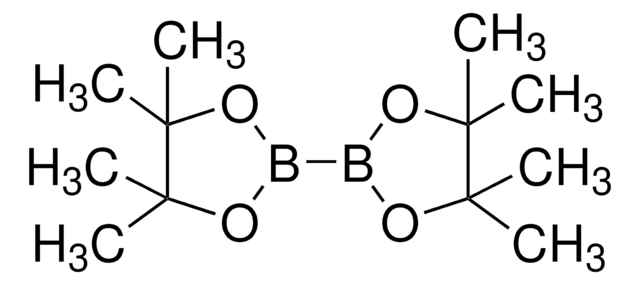
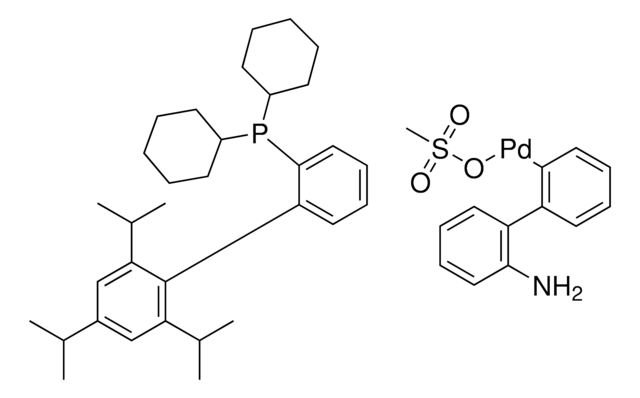
![[1,1′-Bis(diphenylphosphino)ferrocene]dichloropalladium(II) complex with dichloromethane](/deepweb/assets/sigmaaldrich/product/structures/825/986/4317978b-1256-4c82-ab74-6a6a3ef948b1/640/4317978b-1256-4c82-ab74-6a6a3ef948b1.png)
![[Pd(OAc)2]3 reagent grade, 98%](/deepweb/assets/sigmaaldrich/product/structures/508/249/99a0ef2c-b77c-4d73-8ed9-0cca05b6b41f/640/99a0ef2c-b77c-4d73-8ed9-0cca05b6b41f.png)

